Phillies: Most impactful trade made with every team

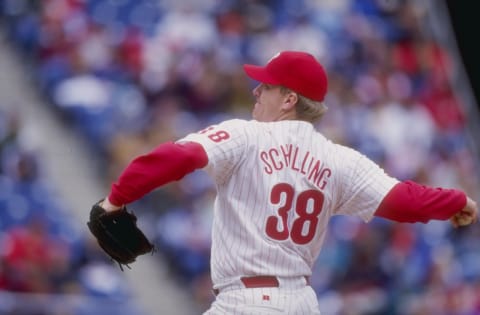
Today we’re breaking down the most impactful trades made with each team in Phillies history.
According to Baseball-Reference the Phillies have made about 873 trades in their 138 years of playing baseball, averaging more than six trades a year. Some deals are multi-team blockbusters and others are swaps for cash considerations.
Whether it’s a blockbuster or a blip on the radar, any trade could be franchise-altering in a multitude of ways, for good and bad.
Today we’re breaking down the most impactful trades made with each team in Phillies history. These aren’t always deals the Phillies won or involved the biggest names. These are deals that changed a season or the course of the franchise.
Arizona Diamondbacks – Curt Schilling
On July 26, 2000, the Philadelphia Phillies traded Curt Schilling to the Arizona Diamondbacks for Omar Daal, Nelson Figueroa, Travis Lee and Vicente Padilla.
This was the first of six trades the Phillies have made with the Diamondbacks, and it was a blockbuster. On July 25 the Phillies lost their 54th game, dropped to 10 games below .500, and were 16 games back in the division. They had to shake things up at the trade deadline to get younger and start building their next core.
Philadelphia’s biggest trade chip was ace Curt Schilling, a future Hall of Fame pitcher who had spent his last nine season with the Phillies. Philadelphia is where Schilling molded himself into one of baseball’s greatest pitchers with three consecutive seasons winning at least 15 games. Twice he led the league with at least 300 strikeouts and in 1997 he finished fourth in the Cy Young race.
Two days before the trade Schilling threw a complete game against the Pirates allowing only one run off three hits. It was as good of a start the Phillies could hope for as the trade deadline approached.
The same day the Phillies lost their 54th game the Diamondbacks lost their third straight and were just one game up in the division. The franchise was in its infancy, just three years old and coming off a playoff appearance. Ready to make a splash, Arizona sent four players in their early and mid-20s to the Phillies to pair Schilling with Hall of Famer Randy Johnson.
While Schilling and Johnson would go on to win a World Series in Arizona, the young players Philadelphia got back didn’t come anywhere close to Schilling’s talent.
Omar Daal would start 44 games for the Phillies with a 4.52 ERA before being traded after the 2001 season. Nelson Figeroa pitched 19 games for Philadelphia in 2001 and was waived the following season. He’d return in 2010 to make 12 relief appearances and one start.
Travis Lee had some pop, but he was limited to first base and was released to make room for Jim Thome.
Vicente Padilla ended up being the best return in the deal, pitching six seasons in Philadelphia and making the All-Star game in 2002. In a stretch of bad Phillies baseball Padilla was often their best starter.
The timing was just never right with the Phillies and Schilling after the ’93 season. When he got good the team got bad, real bad. Had they kept him he could have solidified himself as one of the best pitchers in franchise history. If they’d gotten a better return for him, who knows what could have happened.

Atlanta/Boston Braves: Sherry Magee
On December 24, 1914, the Boston Braves traded players to be named later and cash to the Philadelphia Phillies for Sherry Magee. The Boston Braves sent Oscar Dugey (February 10, 1915) and Possum Whitted (February 14, 1915) to the Philadelphia Phillies to complete the trade.
The Phillies have made 53 trades with the Braves organization, but none since acquiring Kevin Millwood in 2002. While that trade did lead to a no-hitter from Millwood and a prior trade brought Dale Murphy to the Phillies at the end of his career, neither matched the deal that shipped one of the franchise’s best hitters out of town.
Magee is one of the great players in Phillies history many fans know nothing about. Granted, he did play over 100 years ago in the dead-ball era.
Magee’s big league career started as a teenager in 1904, the first of 11 seasons with the Phillies.
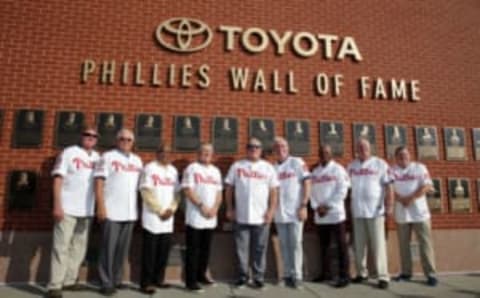
Among all hitters players in Phillies history, Magee’s 48.3 WAR is the fifth-best all-time, only bested by Schmidt, Utley, Delahanty, and Ashburn. He played the 10th-most games (1,521), has the eight-most hits (1,627; more than Utley), the second-most triples (127), sixth-most doubles (337), ninth-most RBI (886), and the fourth-most stolen bases (387).
Going into his age-30 season the Phillies traded Magee, who at that point was the greatest player in franchise history, to the then Boston Braves for Oscar Dugey and Possum Whitted.
Whitted would play parts of five seasons in Philadelphia hitting .274 while Dugey hit just .193 in three seasons.
The season following the trade of Magee the Phillies would win the National League pennant but lose to the Yankees in the World Series.
Magee would “win” a World Championship in 1919 with the Cincinnati Reds after the title was stripped from the infamous “Black Sox” for throwing the series.
At the age of 44 Magee would die from pneumonia in Philadelphia. In 2003 he was inducted onto the Phillies Wall of Fame. He’s also received Hall of Fame consideration from the Veteran’s Committee.
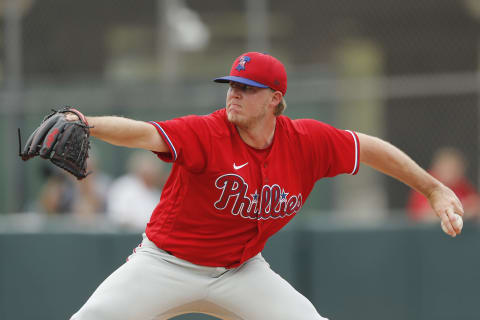
Baltimore Orioles: Garrett Cleavinger
On July 28, 2017, the Philadelphia Phillies traded Jeremy Hellickson to the Baltimore Orioles for Garrett Cleavinger, Hyun Soo Kim and international bonus slot money.
While the Phillies and Orioles have made 36 trades in their respective histories, very few are considered “impactful.”
With this trade, we’re looking a bit into the future with the promise of a young arm who could be a middle reliever for the Phillies as soon as this season.
Jeremy Hellickson originally came up with the Rays and emerged as one of baseball’s best young pitchers. In 2011 he won the Rookie of the Year with 13 wins and a 2.95 ERA, setting himself up for long-term success.
After a mixed bag of seasons in Tampa he was traded to Arizona and subsequently dealt a couple of years later to Philadelphia to fill out the rotation.
Hellickson did his job for the Phillies, winning 12 games in 2016 and had two very good opening day starts. Playing for some bad Phillies teams, Hellickson became quality trade bait for a team seeking a middle of the rotation arm with some upside at a reasonable price.
The Phillies found their trade partner in the Orioles days before the 2017 deadline, sending Hellickson to at team fighting for a playoff spot. In return the Phillies got a depth outfielder in Hyun Soo Kim, international bonus pool money, and prospect Garrett Cleavinger.
Kim didn’t do much for the Phillies, hitting just .230 in 40 games after the trade. He returned to Korea to play in the KBO where he hit .362 with 20 home runs in 2018.
Cleavinger is the only physical return from the trade still in the organization. After a bumpy run in the minors he solidified himself last year as a reliever with a 3.66 ERA in 34 games. Now on the Phillies 40-man roster, the 25-year-old Cleavinger could reach the big leagues as early as 2020.
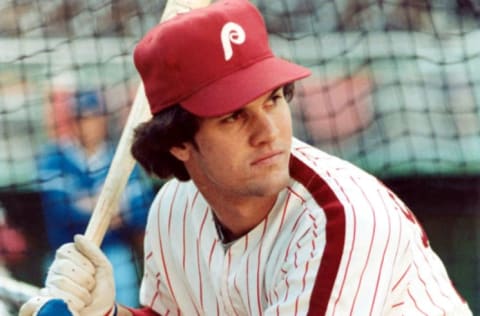
Chicago Cubs: Ryne Sandberg
On January 27, 1982, the Chicago Cubs traded Ivan de Jesus to the Philadelphia Phillies for Larry Bowa and Ryne Sandberg.
The Phillies and Cubs have pulled off some very impactful trades over the years. In one deal the Phillies traded a future Hall of Famer in Fergie Jenkins to Chicago, and in another Philadelphia got back Manny Trillo in an eight-player deal.
In a smaller August trade, the 2008 Phillies boosted their bullpen by acquiring reliever Scott Eyre.
But no trade can match the impact of the 1982 Ryne Sandberg trade.
In 1981 the Phillies were coming off the franchise’s first championship nearly years after its creation in 1983. The player’s strike eliminated nearly two months of the season and the team lost to the Expos in game five of the division series.
Going into the 1982 season the Phillies had an opportunity to get younger while still competing for a championship. They were able to reunite 35-year-old Larry Bowa with Dallas Green in Chicago for 29-year-old Ivan de Jesus.
Green insisted that 22-year-old rookie Ryne Sandberg be included in the deal, which was pulled off in January 1982.
This trade would go down as one of the worst deals in Phillies history with Sandberg going on to become one of the greatest second basemen of all-time as a member of the Cubs.
Over the next 15 years as a Cub Sandberg would have 2,385 hits, 282 home runs, 403 doubles, nine Gold Gloves, an MVP, 10 All-Star games, and seven Silver Sluggers. He was inducted into the Hall of Fame in 2005.
de Jesus was nothing more than average for the Phillies, hitting .249 with 51 doubles and seven home runs in three seasons. The Phillies would trade him after the 1984 season, the same year Sandberg won the MVP in Chicago.

Chicago White Sox: Jim Thome for Aaron Rowand
On November 25, 2005, the Philadelphia Phillies traded Jim Thome and cash to the Chicago White Sox for Gio Gonzalez, Daniel Haigwood, and Aaron Rowand.
At the time, Jim Thome was the biggest free agent addition in Phillies history and signaled a new era in team history with the closing of Veteran’s Stadium and opening of Citizens Bank Park.
Thome was nothing but excellent for the Phillies in his three seasons with the team. He led the league with 47 home runs in his first season and finished fourth in the MVP race. He followed that season up with 42 home runs and an All-Star game selection.
While having Thome was great, the Phillies weren’t making the playoffs and there was a big piece stuck behind him in the minors, Ryan Howard.
Neither Thome or Howard were fit to play a position other than first base, so someone had to go.
When an elbow injury ended Thome’s 2005 season, Howard stepped in and won the Rookie of the Year with 22 home runs in 88 games.
The choice was clear, the Phillies were better off with a cheap 25 year old Ryan Howard compared to a very expensive 34 year old Thome.
Prior to the 2006 season the Phillies sent Thome to the White Sox where his career could continue as a designated hitter. In return, the Phillies got two prospects and center fielder Aaron Rowand.
Prospect Daniel Haigwood only lasted 15 starts in the Phillies system before he was traded to Texas for Fabio Castro. Haigwood pitched in the minors for seven seasons and never made it to the big leagues.
Gio Gonzalez was thrown in as a “player to be named later” and developed into a quality big league starter. While he never played for the Phillies, traded back to the White Sox 363 days later, Gonzalez has pitched 12 seasons for three teams and nearly won a Cy Young in 2012 when he won 21 games for the Nationals.
Rowand was a very productive player, one of the most underrated Phillies players of the early 2000s. He was an All-Star who could hit for power and get on-base while also famously crashing into the outfield fence.
“When I’m done playing baseball if that’s the one thing I get remembered for whether it’s just here in Philadelphia or around the country or whatever, I’ll gladly take that. Anybody that recollects that or thinks about that thinks about the fact that I played the game hard, that I played the game right. I don’t think as a player you could ask for anything more to be remembered for.
Not only did the Phillies get a productive player out of Rowand, they opened a spot for Howard at first base.
Honorable Mentions December 9, 1959. The Philadelphia Phillies traded Gene Freese to the Chicago White Sox for Johnny Callison. December 6, 2006. The Philadelphia Phillies traded Gavin Floyd and Gio Gonzalez to the Chicago White Sox for Freddy Garcia.
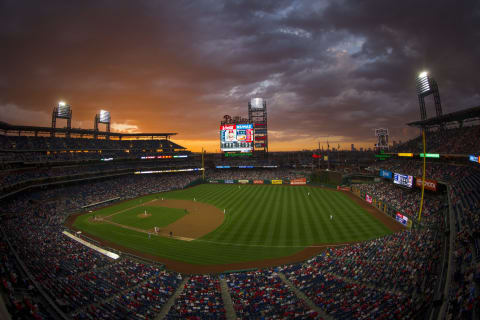
Cincinnati Reds: Tony Gonzalez
On June 15, 1960, the Philadelphia Phillies traded Fred Hopke, Harry Anderson and Wally Post to the Cincinnati Reds for Tony Gonzalez and Lee Walls.
There have been 62 trades between the Phillies and Reds in their respective histories, but few stand out more than the Tony Gonzalez trade from the summer of 1960.
The 1960 Phillies were one of the worst teams in franchise history, winning just 59 games under first year manager Gene Mauch. Richie Ashburn was gone, Robin Roberts was on the back side of his career, and a young second baseman named Tony Taylor was just acquired from the Cubs.
On June 14 the Phillies won an extra-inning game in Los Angeles but were still 13 games below .500 and dead last in the National League early in the season. They needed to find the next generation of talent.
The next day they traded first base prospect Fred Hopke (who’d never reach the big leagues), outfielder Harry Anderson, and power-hitter Wally Post to the Reds. In return, the Phillies got outfielder Lee Walls, an All-Star two years before, and a young Cuban infielder named Tony Gonzalez.
Walls played just one full season in Philadelphia providing minimal help at the plate. The big star in this deal was Gonzalez, a 23-year-old outfielder who would grow into one of the greatest Phillies of all-time.
For nine years all Gonzalez did was hit, racking up 1,110 of them in Phillies pinstripes. In 1967 get hit .339 with nine triples and twice he received MVP consideration.
If you go through the Phillies top-50 hitters for each record, Gonzalez is on the list, if not in the top-25. His 27.5 oWAR is better than Ryan Howard, Tony Taylor, Juan Samuel, and many other great Phillies.
Honorable Mention
August 5, 1975. The Philadelphia Phillies traded Dave Schneck to the Cincinnati Reds for John Vukovich.

Cleveland Indians: Cliff Lee
On July 29, 2009, the Cleveland Indians traded Ben Francisco and Cliff Lee to the Philadelphia Phillies for Jason Knapp, Carlos Carrasco, Jason Donald and Lou Marson.
The 2009 Cliff Lee trade was one of the biggest blockbuster trades in recent memory for Phillies fans when it all went down at the trade deadline.
Coming off the 2008 World Series the Phillies were even better the following season. While they’d lost Pat Burrell, a majority of the team returned with the addition of Raul Ibanez in left field.
The pitching was not as strong in 2009 as it was in ’08. Cole Hamels was still coming off his championship high, and the trio of Brett Myers, Jamie Moyer and Chan Ho Park all disappointed, whether it be because of injuries or general decline.
The Phillies had the offense to win, but they needed pitching. On July 15 they signed future Hall of Famer Pedro Martinez off the street. Rookie J.A. Happ made a big impact, winning 12 games with a 2.93 ERA and finishing second to Chris Coghlan (who hit .321) in the Rookie of the Year race.
But the Phillies needed an ace. They tried to get Roy Halladay, but came up short that summer. The second-best option was Indians ace and reigning AL Cy Young winner Cliff Lee.
Saving top prospects Domonic Brown and Kyle Drabek, the Phillies sent four players to Cleveland who were good prospects, but there was no room for them on the big league team.
Catcher Lou Marson was stuck behind Carlos Ruiz. Jason Donald was stuck behind Chase Utley. They were both expendable and neither developed into an everyday big league player.
Pitcher Jason Knapp was a top-100 prospect and a second round pick out of New Jersey who never played above High-A ball.
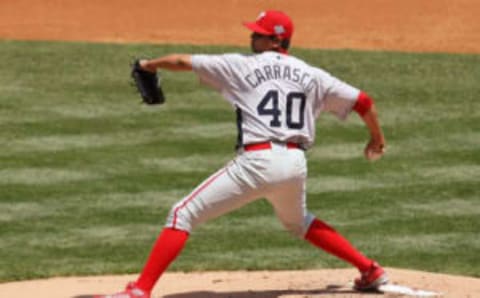
The biggest loss for the Phillies in this deal was Carlos Carrasco, who was a late bloomer that developed into a top of the rotation pitcher for Cleveland. He didn’t turn into a bonafide big league starter until he was 27 in 2014, but when healthy he’s one of the best in baseball.
Philadelphia also got outfielder Ben Francisco in the deal to sure up the bench. In 19 games as a starter for the Phillies that season Francisco hit .291 with five home runs.
But the prize was Lee, one of the best pitchers in baseball coming off a terrible team and ready for a playoff run.
In his first game with the Phillies Lee threw a complete game, his first of three for Philadelphia that year. In 12 regular season starts Lee had a 3.39 ERA and dominated in nearly every game en route to a playoff berth.
During the playoffs Lee was better than advertised, pitching into the eighth inning in all five of his starts with two complete games.
In his first-ever playoff game Lee threw one of those complete games and stole a base against the Rockies at home.
In game one of the World Series he struck out 10 Yankees in a lineup that included Jeter, A-Rod, Cano, Matsui, Texiera, Damon, Gardner, and Posada.
The ’09 season certainly didn’t end as everyone hoped, but it went about as well as it could have for Lee.
Honorable Mention
December 9, 1982. The Cleveland Indians traded Von Hayes to the Philadelphia Phillies for Jay Baller, Julio Franco, Manny Trillo, George Vukovich and Jerry Willard.
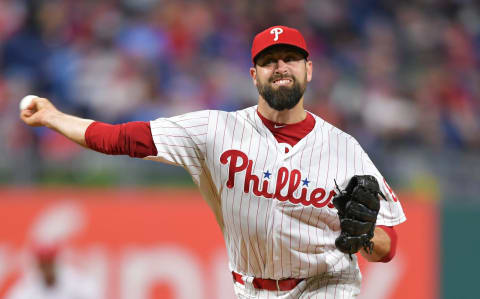
Colorado Rockies: Pat Neshek
On July 26, 2017, the Philadelphia Phillies traded Pat Neshek to the Colorado Rockies for Jose Gomez, Alejandro Requena and J.D. Hammer.
The Phillies and Rockies have only made four trades since the Rockies’ first season in 1993. No offense to Ty Wiggington, Ed Vosberg, and James Pazos, but none of those deals are “impactful.”
In 2017 the Phillies made an attempt to squeeze into the playoffs by adding veterans like Howie Kendrick, Michael Saunders, Joaquin Benoit, and Pat Neshek. If the team overperformed, they would have some veterans ready to help in the locker room and on the field. If the team underperformed, they had some trade bait.
Winning just 66 games in 2017, it became clear these guys were going to be trade bait.
Neshek was arguably the Phillies best player that season with a ridiculous 1.12 ERA and 45 strikeouts in 43 games. His stuff was as electric as it was bizarre with a submarine style arm.
He was also a great guy off the field, offering to sign anything fans sent his way.
On July 1 the Phillies were 20 games back in the division and at one point that month they were 30 games under .500, a terrible team stuck in a rebuild.
While the Saunders signing didn’t result in the trade value GM Matt Klentak hoped for, Neshek became a hot commodity for teams looking for a dominant setup man or closer. This trade with the Rockies was about the best Klentak could have hoped for.
The Phillies were able to get three pretty solid prospects back for Neshek, something rarely heard of when you’re trading a 36-year-old setup man on a one-year deal.
Infielder Jose Gomez was one of the Rockies’ top-30 prospects at the time of the deal and he moved onto the Phillies list once the deal was done. He’s still a very infielder in the Phillies system who hit .266 between Clearwater and Reading last season.
Starting pitcher Alejandro Requena had a very promising start to his career in the Phillies system, posting a 3.44 ERA in 2018 between Rookie ball and Clearwater. He struggled in 2019 when he moved up in the system with an ERA of 4.86 in Clearwater and Reading. If the season started today he would likely start in one of those two’s rotations.
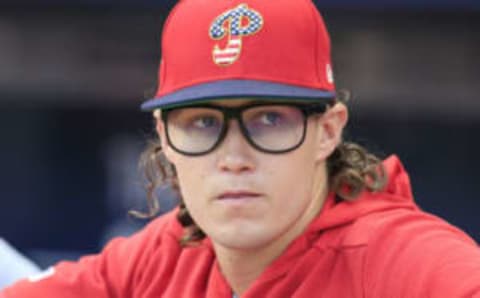
J.D. Hammer, a hard-throwing reliever straight out of Major League, is the biggest mystery of the deal. The minute the trade was made he became a fan favorite with his big glasses and long hair.
Hammer came up in 2019 and had a really good start to his career with three shutout appearances with five strikeouts. In 15 of his 20 appearances he allowed no earned runs and allowed no more than two in any outing.
Shockingly, the Phillies designated him for assignment and moved him to the minors to start 2020. There must be something that fans aren’t aware of because Hammer seemed like too good of an arm to throw out there on the waiver wire.
Hopefully all is well and Hammer contributes to the big league roster sooner rather than later.
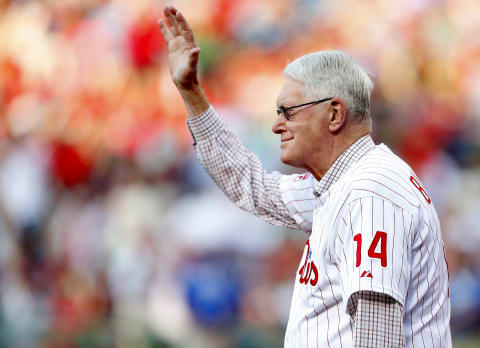
Detroit Tigers: Jim Bunning
On December 5, 1963, the Philadelphia Phillies traded Don Demeter and Jack Hamilton to the Detroit Tigers for Jim Bunning and Gus Triandos.
While it’s certainly not the most recent deal in Phillies history, the trade that brought Jim Bunning to Philadelphia is one of the best in team history.
In the early 1960s the Phillies had some of the worst teams in franchise history, winning just 59 games in 1960 and only 47 the season after. The emergence of young players like Johnny Callison, Tony Taylor, and Tony Gonzalez helped propel the team to back-to-back seasons with at least 80 wins, something they hadn’t done in nearly a decade.
Ready to propel the team into a playoff chase, Phillies general manager John Quinn traded for 31-year-old All-Star pitcher Jim Bunning and veteran catcher Gus Triandos, who spent less than two seasons with the team.
Coming off seven consecutive double-digit win seasons, Bunning was one of baseball’s best pitchers and instantly became a workhorse for the Phillies.
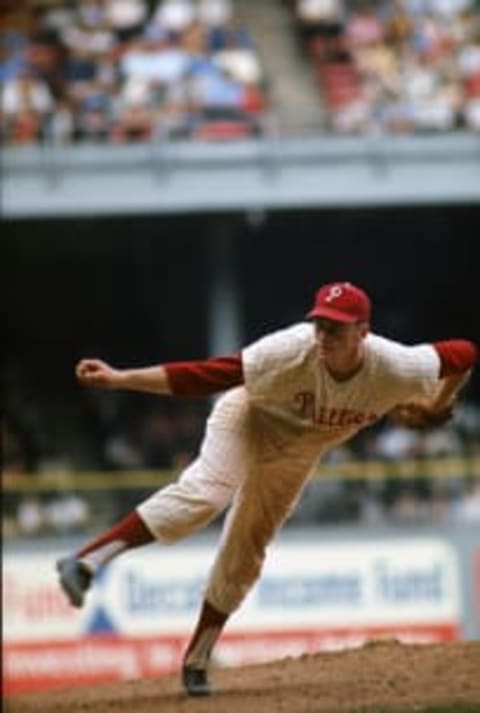
Bunning won 19 games in three consecutive seasons to start his career in Philadelphia, helping them win 92 games in 1964, the most wins by the franchise in the 20th century.
In his first four seasons with the Phillies Bunning won 74 games with 60 complete games and nearly 1,000 strikeouts. He was named to two All-Star teams and finished second in the Cy Young race at the age of 35 when he led the league with 253 strikeouts in a league-high 302.1 innings.
After the ’67 season the Phillies traded Bunning to Pittsburgh in a four player deal that brought Don Money to Philadelphia.
Bunning would return to the Phillies in 1970 after stints in Pittsburgh and Los Angeles, and pitched two more years for Philadelphia.
In 1996 he was elected to the Baseball Hall of Fame by a Veteran’s Committee and his number 14 was retired by the Phillies. Later in his life Bunning was elected to the United States Senate and served the state of Kentucky.
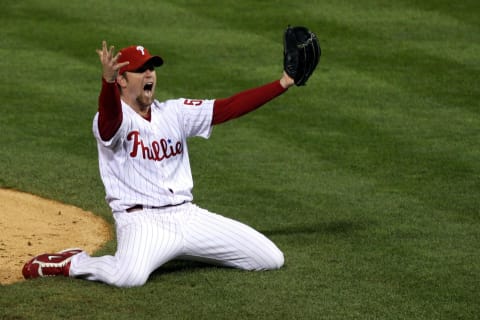
Houston Astros: Brad Lidge
On November 7, 2007, the Houston Astros traded Eric Bruntlett and Brad Lidge to the Philadelphia Phillies for Michael Bourn, Mike Costanzo and Geoff Geary.
The Phillies and Astros have made 22 trades over the years and you could name five or six of them as the most impactful one made.
Houston has always been sort of a farm system for the Phillies to pick out of when they needed one last piece to make a run. They added Curt Schilling, Billy Wagner, Hunter Pence, and Roy Oswalt in deals to do just that.
The Phillies also swapped roles and sent Ken Giles to Houston in a package of prospects that included Vince Velasquez and former number one pick Mark Appel.
While each of those trades made a major impact, no deal did more for the Phillies run for a championship than the deal that brought Brad Lidge to Philadelphia.
In 2007 the Phillies won the division despite not having the most sound closer situation. Former starter Brett Myers got the job done with 21 saves. Antonio Alfonseca, Tom “Flash” Gordon, and Jose Mesa were in their late 30s, early 40s with very his ERAs.
Shortly after the season ended the Phillies immediately went out and traded for Lidge, who had a rollercoaster career in Houston. At one point Lidge saved 42 games and had seasons that garnered support for the Cy Young and Rookie of the Year. Other years he had an ERA over five.
The deal cost Philadelphia Michael Bourn, a speedy center fielder who would win multiple Gold Gloves, infield prospect Mike Costanzo (who would play17 big league games with a .056 BA), and veteran reliever Geoff Geary, who would be out of the league by 2010.
Philadelphia also received utility man Eric Bruntlett, who could play nearly every position and later turned a game-ending unassisted triple-play.
Lidge would turn out to be pretty good himself, completing all 41 of his regular season save opportunities and seven additional saves in the postseason, including the final strikeout of the World Series.
Despite injuries Lidge managed 31 saves the following year and 27 more in 2010, finishing with 100 regular season saves in red pinstripes, now the fifth-most in team history.
Lidge will one day be on the Wall of Fame for his heroics in 2008 and the memory of his final out is ingrained in the memories of Phillies fans everywhere.
Honorable Mention: April 2, 1992. The Philadelphia Phillies traded Jason Grimsley to the Houston Astros for Curt Schilling. November 3, 2003. The Houston Astros traded Billy Wagner to the Philadelphia Phillies for Ezequiel Astacio, Taylor Buchholz and Brandon Duckworth. July 29, 2011. The Houston Astros traded Hunter Pence and cash to the Philadelphia Phillies for Domingo Santana, Jarred Cosart, Jon Singleton and Josh Zeid. July 29, 2010. The Houston Astros traded Roy Oswalt to the Philadelphia Phillies for Anthony Gose, J.A. Happ and Jonathan Villar. December 12, 2015. The Philadelphia Phillies traded Jonathan Arauz and Ken Giles to the Houston Astros for Mark Appel, Harold Arauz, Tom Eshelman, Brett Oberholtzer and Vince Velasquez.
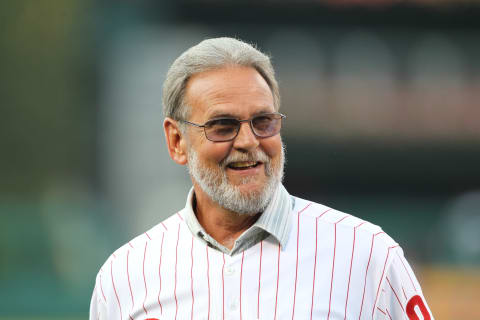
Kansas City Royals: Gene Garber
On July 12, 1974, the Philadelphia Phillies purchased Gene Garber from the Kansas City Royals.
The Phillies and Royals have only made six deals and while this one isn’t a blockbuster, it stands out above the rest as both the first of those six and as the only deal that brought an impactful player to the Phillies
In 1974 the Phillies were getting ready to peak out of their playoff drought that had lasted since 1950. They were in about the same spot the Phillies of the mid-2000s were, a bunch of young guys fighting for a playoff spot but always coming up a couple of games short.
With Danny Ozark at the helm, the Phillies were 38-37 on July 1 and within reach of the division lead. They finished June and started July with an eight game losing streak, diminishing their playoffs hopes even more.
On July 12 the team won their six of their last nine games. They had the offense, they had some starting pitching, but their bullpen was rough. In the first half of the season the relievers had a 4.81 ERA with 103 walks in 185.1 innings. Something needed to be done.
General manager Paul “The Pope” Owens purchase right-handed reliever Gene Garber from the Kansas City Royals. The 26-year-old Garber had pitched parts of four seasons for Pittsburgh and Kansas City, but he was far from a sure thing.
After the trade Garber helped turn around the bullpen with a 2.06 ERA in 34 games. In the second half the bullpen’s ERA dropped nearly an entire point. The trade of Garber mixed with the addition of Pete Richert helped propel the team to an 80-82 season.
Garber would become a centerpiece to the Phillies bullpen in the late 70s with a 2.68 ERA and 51 saves. In 1975 he led the league with 71 appearances and 47 games finished.
Philadelphia would trade Garber to Atlanta to reacquire Dick Ruthven and Garber began a long career with the Braves, including a 30 save season in 1982.
In 1978 he ended Pete Rose’s 44 game hit streak with a strikeout.
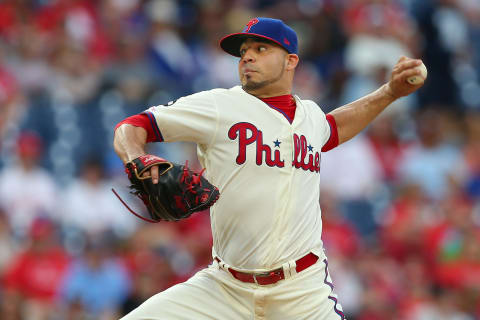
Los Angeles Angels: Jose Alvarez
On December 6, 2018, the Philadelphia Phillies traded Luis Garcia to the Los Angeles Angels for Jose Alvarez.
While it’s not the most exciting trade in team history, the Jose Alvarez deal stands out among the 20 deals made between the two teams.
After the 2018 season the Phillies needed to sure-up their bullpen by adding a quality reliever who could also provide some stability in a very unstable group of arms.
When the deal did come down, it was a bit confusing as to why the Angels would pull the trigger. Both Luis Garcia and Alvarez have two more years of arbitration eligibility remaining, but Alvarez was two years young and in 2018 he had the best season of his young career.
In 76 relief appearances with the Angels in 2018 Alvarez went 6-4 with a 2.71 ERA and a 1.159 WHIP. Garcia spent parts of six seasons with the Phillies and was a constant headache for fans with a career ERA of 4.12 at the time of the deal.
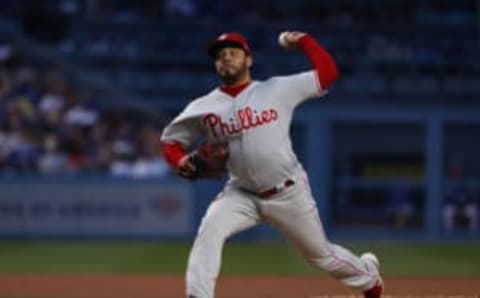
Alvarez initially struggled in his first four appearances, allowing six earned runs with a 20.25 ERA. In his final 63 appearances he had a 2.56 ERA with 48 strikeouts, quietly solidifying himself as one of the Phillies best relievers.
From July 4 to August 10 (14 appearances) Alvarez didn’t allow a single earned run and won three games. He also had four stretches of six straight games without an earned run allowed.
Garcia would have a 4.35 ERA and allow eight more earned runs than Alvarez with nearly twice as many walks.
It’s not the flashiest deal, but it’s a deal the Phillies certainly won.
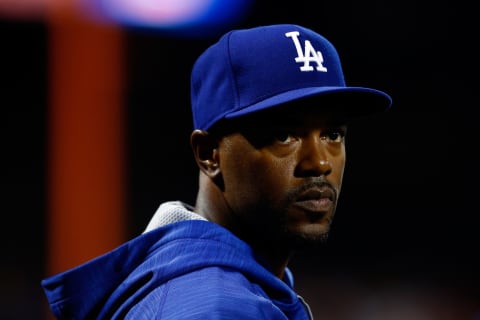
Los Angeles Dodgers: Jimmy Rollins for Zach Eflin
On December 19, 2014, the Philadelphia Phillies traded Jimmy Rollins and cash to the Los Angeles Dodgers for Tom Windle and Zach Eflin.
No trade is more impactful for a franchise than when you trade your all-time hits leader and the greatest shortstop in team history.
The Jimmy Rollins trade was a sign that the Phillies were seriously ready to move on and rebuild. They had moved other players like Shane Victorino and Hunter Pence, but trading a key piece of the 2008 team and handing the shortstop job over to Freddy Galvis was a sign of the times in Philadelphia.
Rollins was clearly at the end of his borderline Hall of Fame career coming off a career-worst .243 batting average. The former MVP and Gold Glove winner took his talents to Los Angeles and struggled just as much in 2015, seeing his average drop even more.
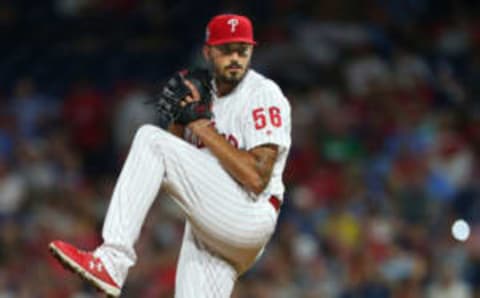
Thankfully the Phillies still got a very solid return for Rollins with pitcher Zach Eflin.
To get anything in return for Rollins at that point in his career was exceptional. If Eflin is to materialize into at the worst a quality number five pitcher, the Phillies made out ok. Eflin wasn’t even ranked in the Dodgers top-20 prospects at the time of the deal, but he’s shown flashes of being a quality starting pitcher for the Phillies over the last four years, including throwing two complete games in 2019.
Tom Windle, the ninth-ranked prospect in the Dodgers system, was the second player to come over in the deal, was in the Phillies farm system as recently as last season pitching for AAA Lehigh Valley. Philadelphia had transitioned him into a reliever, but he could never get his ERA below four. They released him in August and he was assigned to the Red Sox Low-A team at the age of 27.
Honorable Mention
August 7, 2014. The Philadelphia Phillies traded Roberto Hernandez to the Los Angeles Dodgers for Victor Arano and Jesmuel Valentin.
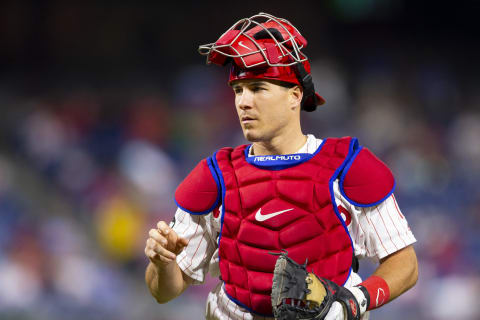
Miami Marlins: J.T. Realmuto
On February 7, 2019, the Miami Marlins traded J.T. Realmuto to the Philadelphia Phillies for Sixto Sanchez, Will Stewart, Jorge Alfaro and international bonus slot money.
Ever since 2008 World Series champion Carlos Ruiz played his last game in red pinstripes for the Phillies in 2016, it appeared that the franchise’s next perennial catcher would be the prospect they traded for one season prior in July, Jorge Alfaro.
Alfaro came to the Phillies from the Rangers, along with Alec Asher, Jerad Eickhoff, Matt Harrison, Jake Thompson and Nick Williams, as part of the Cole Hamels trade. In parts of three seasons from 2016-18, Alfaro slashed .270/.327/.422 in red pinstripes with 22 doubles, 15 home runs, 51 RBI, 22 walks and 179 strikeouts across 143 games and 508 plate appearances.
Despite Alfaro playing just one full season for them, the Phillies saw an opportunity to improve their backstop, roughly one month before they would go on to sign Bryce Harper to a then-record-breaking deal (before Mike Trout would surpass that not too long after).
In early February 2019, they acquired then-one-time All-Star and Silver Slugger Award-winning J.T. Realmuto in exchange for top pitching prospect Sixto Sanchez, fellow minor-leaguer Will Stewart and international bonus slot money.
The decision proved to be an excellent one, as Realmuto instantly was a difference maker both with his bat and glove behind the plate. Across 145 games, he slashed .275/.328/.493 with 36 doubles, 25 home runs and 83 RBI; in the field, he committed just nine errors across 1,174 chances (99.2 fielding percentage), and threw out the most runners attempting to steal among National League catchers (43).
Realmuto would be the 2019 Phillies’ lone All-Star; he finished 14th in the MVP race, but ended up coming away with his second-career Silver Slugger and first-career Gold Glove nod.
He is no Bob Boone or Ruiz, yet, but a few deep playoff runs with at least one ending up with a World Series championship and Realmuto would instantly rank among the all-time bests to ever play catcher as a Phillie.
– Matt Rappa contributed to this report
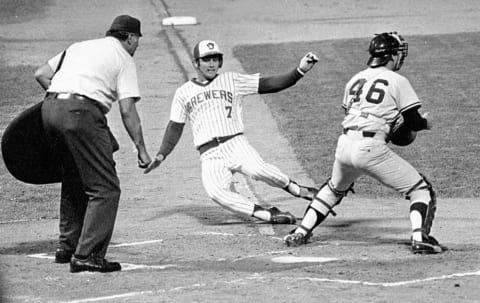
Milwaukee Brewers: Don Money
On October 31, 1972, the Milwaukee Brewers traded Ken Brett, Jim Lonborg, Ken Sanders and Earl Stephenson to the Philadelphia Phillies for Bill Champion, Don Money and John Vukovich.
The history of Phillies trades with the Milwaukee Brewers/Seattle Pilots organization is short and simple. They’ve made only 16 deals since 1971 and three of those are straight-up contract purchases.
The most notable name on the list of trades is Don Money, the Phillies young infielder who would go on to be an All-Star in Milwaukee.
In his first three full-time seasons with the Phillies, Money had a rollercoaster career. In his first and last season with the team he hit .226 and averaged about 100 hits a season. The season in between those he hit .295 with 14 home runs.
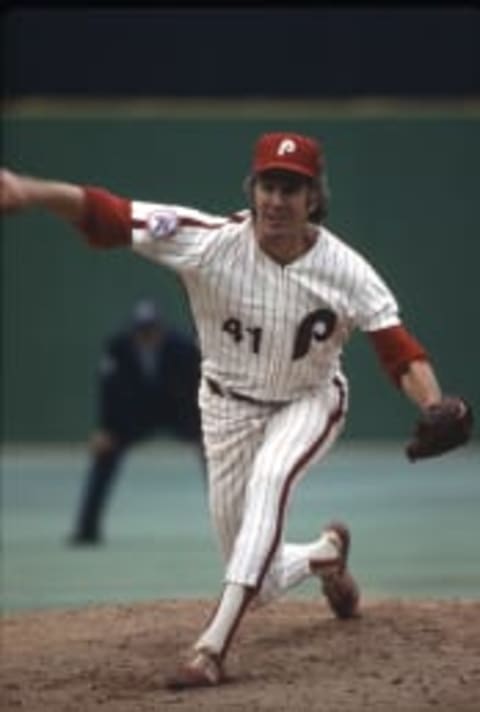
While the prospects were high for Money, the Phillies had to make room for Larry Bowa and Mike Schmidt. Shortly after the 1972 season the Phillies traded Money to Milwaukee along with a young infielder in John Vukovich (who would later return as a beloved player and coach), and pitcher Bill Champion.
Money went on to start 11 seasons for the Brewers with four All-Star game selections. He remains in the organization as a player development instructor and was inducted into the Milwaukee Brewers Walk of Fame in 2005.
Ken Brett would win 13 games for the Phillies in 1973, but was traded to Pittsburgh for Dave Cash. He would play for 10 teams in 14 years and made one All-Star game for the Pirates.
Veteran pitcher Jim Lonborg had won the Cy Young in 1967, but he ended up spending the majority of his long baseball career with the Phillies. In seven seasons Lonborg won 75 games for the Phillies from 1973-79.
Earl Stephenson never played a game for the Phillies, making only 53 appearances for Triple-A Eugene in ’73 before the Expos selected him in the Rule 5 Draft.
A month after the trade, Ken Sanders was traded to Minnesota in a four-player deal for César Tovar.
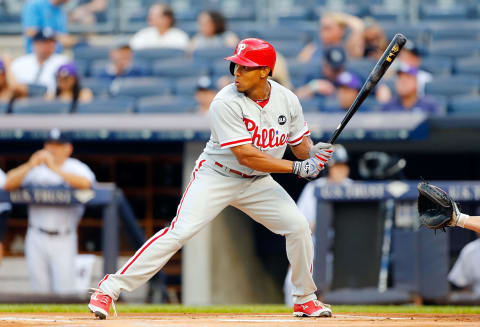
Minnesota Twins: Ben Revere
On December 6, 2012, the Minnesota Twins traded Ben Revere to the Philadelphia Phillies for Trevor May and Vance Worley.
There’s very little to discuss when looking for the most impactful trade between the Phillies and Brewers. They made 13 deals where players were simply purchased, and a handful of other deals that were simply conditional or waiver pickups.
I’m not counting the deal where the Phillies traded future manager Pete Mackanin for Paul Thormodsgard in 1971 either.
The one deal that does stick out is the 2012 Ben Revere trade.
A lot of fans never got that excited with Ben Revere, a speedy center fielder who could hit and play Gold Glove defense. He wasn’t super flashy, but he got the job done. What more could you ask from a player? I think in another era of Phillies baseball there would be more appreciation for what Revere did.
What exactly did Revere do? In three seasons with the Phillies, he hit .303 while playing nearly every game and stole 95 bases, including 49 in 2014. That same season he led the league with 184 hits.
As the leadoff hitter Revere didn’t drive in runs and on a bad team he didn’t score many runs despite a high on-base percentage and the ability to steal a bag at will. In three years he had only 71 RBI and never had more than 28 in a season with the Phillies.
He also made one of the greatest catches in Phillies history.
The Phillies did give up a lot for Revere at the time with the hopes of replacing Shane Victorino.
Trevor May was the big prospect who went in this deal, ranked fourth in the Phillies farm system in 2011 by MLB Pipeline. Like Carrasco, May was a late-bloomer with a 5.14 ERA in his first three seasons with the Twins. After a year away from the big league team May has turned into one of their best relievers with a 3.01 ERA in 89 games with 115 strikeouts.
Vance “The Vanimal” Worley was a fan-favorite who finished third in the Rookie of the Year race in 2011 when he won 11 games with a 3.01 ERA. Unfortunately for Worley his career never took off like it started and he’s bounced around the league. He had one of the best sinkers I’ve ever seen and picked up a ton of called third strikes with it.
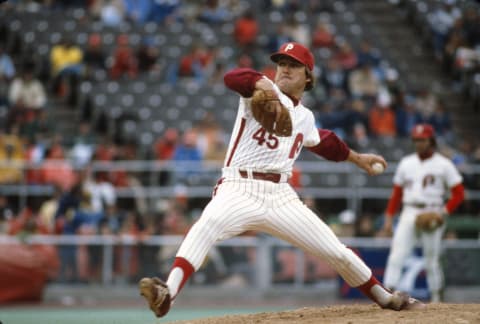
New York Mets: Tug McGraw
On December 3, 1974, the New York Mets traded Don Hahn, Tug McGraw and Dave Schneck to the Philadelphia Phillies for Mac Scarce, John Stearns and Del Unser.
Tug McGraw had been a big piece of the Mets bullpen for 9 seasons dating back to 1965. In his nine year career in New York he finished with 3.39 FIP, 618 K’s and 86 saves in 792.2 innings pitched. But after his 1974 season was disappointing, posting a record of 6-11 with a 4.20 FIP and 5.5 K/9 in 88.2 innings, the Mets were quick to trade him away.
On December 3rd, 1974, the Mets stopped believing, Philadelphia sent outfielder Del Unser, infielder John Stearns and reliever Mac Scarce to New York for Tug McGraw, and outfielders Dave Schneck and Don Hahn. Luckily for Philadelphia McGraws down season was due to a cyst that was giving him trouble with his delivery. He got it removed in the offseason and bounced back in his first season as a Phillie going 9-6 with a 3.41 FIP in 102.2 innings.
Tug continued to post solid numbers through his next five seasons in Philadelphia en route to throwing the final pitch in game 6 of the 1980 World Series to secure the first title in Phillies history. He ended his career in a Phillies uniform pitching 10 seasons for them. As a Phillie he posted a record of 49-37 with a 3.11 FIP, 94 saves and 491 K’s in 722 innings.
Dave Schneck and Don Hahn never recorded a hit for the Philadelphia Phillies.
As for the Mets they didn’t make out too bad in the trade. Unfortunately, Mac Scarce only faced one batter in his career as a Met, while Del Unser only played two seasons in New York slashing .271/.316/.375 in 224 games posting a WAR of only 3.6.
The brightest part of the deal for New York was John Stearns. Nicknamed “Bad Boy”, his first season after the trade was just that, he slashed .189/.268/.284 in 59 games. After that dreadful season he ended up being a productive bat for the Mets the next nine seasons. He finished off his career as a Met slashing .259/.341/.375 in 809 games posting a WAR of 19.7.
– George Rider contributed to this report
Honorable Mention
June 18, 1989. The New York Mets traded a Tom Edens, Lenny Dykstra and Roger McDowell to the Philadelphia Phillies for Juan Samuel.
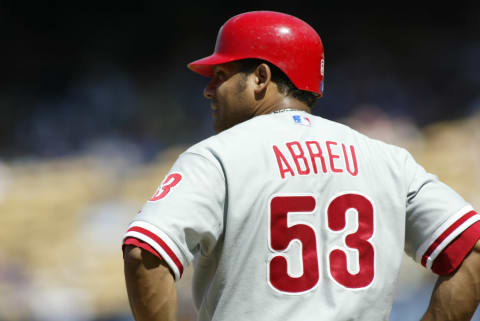
New York Yankees: Bobby Abreu
On July 30, 2006, the Philadelphia Phillies traded Bobby Abreu and Cory Lidle to the New York Yankees for C.J. Henry, Jesus Sanchez, Carlos Monasterios and Matt Smith.
Bobby Abreu, among the Phillies’ newest Wall of Fame inductees who recently appeared on the Baseball Hall of Fame ballot for the first time (5.5%), will go down as being among the players that helped transition the team from Veterans Stadium to Citizens Bank Park. In fact, he became the first player in the latter venue’s history to record a home run, run and RBI, all in the first inning at the April 12, 2004, home opener.
Across parts of nine seasons with the team from 1998 to 2006, the Maracay, Venezuela, native slashed .303/.416/.513 with 348 doubles, 42 triples, 195 home runs, 815 RBI, 254 stolen bases, 947 walks and 1,078 strikeouts. Not to mention, Abreu was a staple as the team’s right fielder; among National League players at the position, he recorded the most putouts in 2000 (338); for assists, he recorded the most in both 1998 (17) and 2000 (13). In 2005, he earned his first and only career Gold Glove Award.
Abreu was just as impactful at the plate, logging a Silver Slugger Award in 2004, a NL-best 11 triples in 1999, and an MLB-best 124 walks in 2006.
Ultimately, as part of Pat Gillick‘s early moves made as Phillies general manager, Abreu was dealt away to the New York Yankees, along with starting pitcher Cory Lidle. Abreu finished 2006 batting .330 in 58 games in Yankees pinstripes; he finished his career playing for them until 2008, followed by the Los Angeles Angels (2009-12), Los Angeles Dodgers (2012) and New York Mets (2014). The Phillies brought back Abreu for 2014 spring training, however he was ultimately released in late March, before signing just days later with the Mets.
Abreu played 18 seasons, and, his 1,476 career walks ranks 20th in MLB history. Nearly 950 of them (947) came while a member of the Phillies.
– Matt Rappa contributed to this report
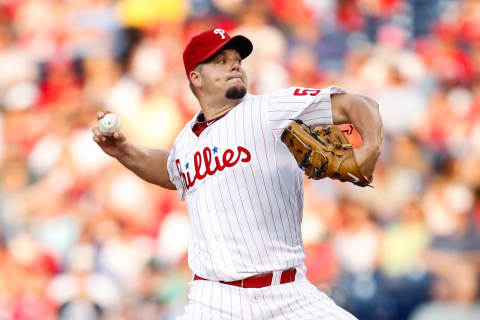
Oakland Athletics: Joe Blanton
On July 17, 2008, the Oakland Athletics traded Joe Blanton to the Philadelphia Phillies for Matthew Spencer, Adrian Cardenas and Josh Outman.
While not the biggest name the Phillies have ever picked up, the Joe Blanton deal helped solidify the Phillies rotation going into the playoffs and eventually the World Series.
Amazingly, the 2008 Phillies only used seven starting pitchers the entire season. They had a young Cole Hamels and a veteran Jamie Moyer at the top of the rotation.
Brett Myers moved back into the rotation full time after closing out the division-clinching game in 2007, finishing the ’08 regular season with a 4.55 ERA.
A young Kyle Kendrick made 30 starts with a 5.49 ERA and J.A. Happ came up to make four relief appearances.
Adam Eaton was also in the mix, but was widely unpopular in the fanbase with his 5.80 ERA.
The back end of the Phillies rotation was really unsteady and the team needed some depth.
Unable to land ace C.C. Sabathia from the Indians, the Phillies went with a much cheaper option in Joe Blanton, a former first round pick of the A’s. Blanton certainly wasn’t the biggest splash coming out of Oakland with a 5-12 record and a 4.96 ERA. He dropped his ERA in Philadelphia in 13 starts and won four games with no losses, generally getting a quality start and leaving the rest to a steady bullpen.
Blanton started game four of the NLDS, NLCS, and World Series that season with a 3.18 ERA and 18 strikeouts in 17 innings. He got a critical win in the World Series going six innings with seven strikeouts and a home run at the plate.
While not the perfect pitcher, Blanton kept the Phillies in games for the next three and a half seasons, working with some of the games best pitchers in the Four Aces rotation.
Prospect Matthew Spencer, Philadelphia’s third round pick in 2007, would never reach the big leagues after the trade. Adrian Cardenas, a late first round pick by the Phillies in 2006, played just 45 games for the Cubs in 2012. Josh Outman, a 10th round pick in 2005, made 161 appearances for four teams with a 4.43 ERA. He hasn’t played in the big leagues since 2014.
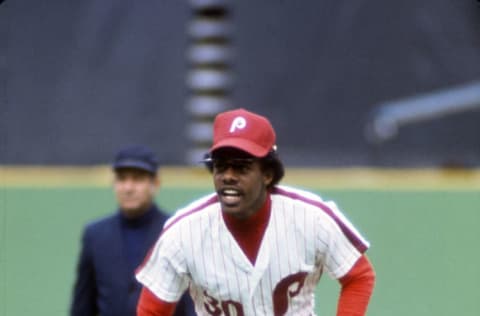
Pittsburgh Pirates: Dave Cash
On October 18, 1973, the Pittsburgh Pirates traded Dave Cash to the Philadelphia Phillies for Ken Brett.
The Phillies of the early 70s were a group of young, budding stars who were still finding their way in the league. Greg Luzinski, Larry Christenson, Bob Boone, Dick Ruthven, and Mike Schmidt were all 25 or younger. Christenson was actually just 19 when he came up in 1973.
In 1972 the Phillies had won just 59 games under Frank Lucchesi and GM-turned-manager Paul Owens. The following year under manager Danny Ozark they made the jump up to 71 wins, but they needed a couple more pieces before they were going to win consistently.
Shortly after their season ended in 1973, The Pope got his team a new second baseman from their cross-state rivals in Pittsburgh. Dave Cash was slated to replace Denny Doyle, who would be designated as the “player to be named later” in a deal made with the Angels earlier that year.
Cash came in and was a consistent player out of the gate, leading the league in at-bats in all three of his seasons in Philadelphia. Not only was he available, but he could hit, nabbing over 200 hits with a .300+ batting average in his first two seasons.
Twice, Cash set the Phillies single-season at-bat record and held the title with 699, though Juan Samuel and Jimmy Rollins have since broken that record. Since 1970 Cash has the most, second-most, and third most singles in a season for the Phillies. Ben Revere tied that third place since 1970 record with 162 singles.
He would also be named an All-Star in all three of those seasons and finished in the top-16 in the MVP face each of those years.
In his three seasons with the Phillies Cash would hit .296 with 113 extra-base hits. While he was there the Phillies turned into a championship-caliber team, winning 101 games and reaching the NLCS in 1976.
Cash left the team after the ’76 season and signed with the Expos as a free agent. He spent three years in Montreal before being traded to San Diego, where he played his final season in 1980.
As for Ken Brett, the man the Phillies traded to Pittsburgh to acquire Cash, he was an All-Star in his first year with the Pirates, winning 13 games with a 3.30 ERA, very similar numbers to what he put up in Philadelphia. His career would then go on a journey through six other cities where he never made another All-Star team.
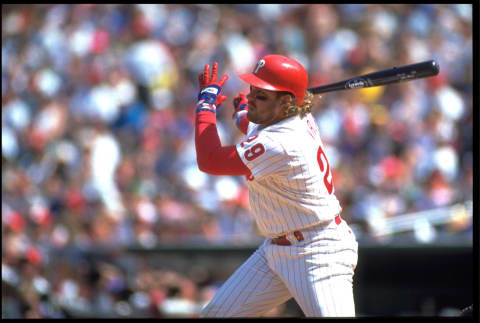
San Diego Padres: John Kruk
On June 2, 1989, the San Diego Padres traded John Kruk and Randy Ready to the Philadelphia Phillies for Chris James.
The Phillies 1989 trade for John Kruk helped set the franchise’s course for an unexpected National League pennant run in 1993.
Coming off their championship runs in the early 80s the Phillies hit a rut, similar to when the 2008 team aged and moved on. After losing the 1983 World Series the Phillies averaged 75 wins a season and had six different managers between 1984-92.
After winning 65 games in ’88 and 67 the following year the team improved by as many as 11 wins over the next three years. The addition and emergence of players like Kruk, Lenny Dykstra, Darren Daulton, and other members of the future pennant team.
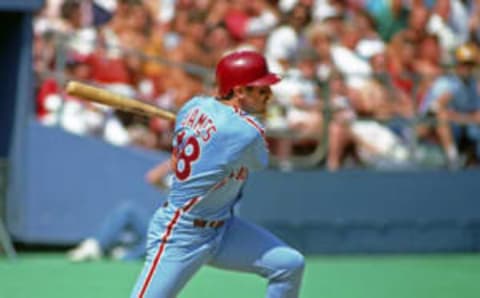
In the middle of their 67 win season the Phillies traded outfielder Chris James, who finished sixth for the Rookie of the Year in 1987, to San Diego. Ready averaged 18 home runs in his first two seasons with the Phillies but would become a journeyman platoon player for the rest of his 10 year career.
At the end of the 1989 season the Padres traded James with Sandy Alomar and Carlos Baerga to the Cleveland Indians for Joe Carter.
In Randy Ready the Phillies got a veteran utility player who played at least 160 games at three different positions in his career. He was an average hitter who got on base, but had little pop. He left after the ’91 season and returned for the 1994-95 seasons.
Kruk was obviously the biggest get for either team in this deal. A fan favorite who could hit for average and power, Kruk went to three All-Star games and received MVP consideration in the early 90s.
Kruk would move into the Phillies broadcast booth and was inducted onto the Wall of Fame as a beloved member of the ’93 team.
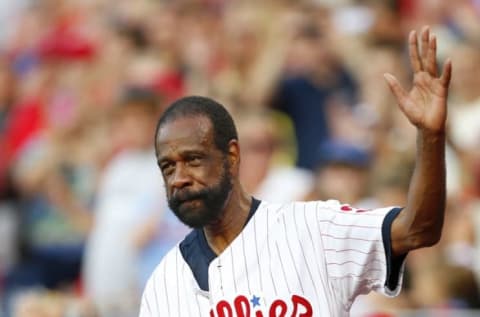
San Francisco Giants: Garry Maddox
On May 4, 1975, the San Francisco Giants traded Garry Maddox to the Philadelphia Phillies for Willie Montanez.
The Secretary of Defense came to the Phillies in one of the most underrated trades in franchise history which helped seal the Phillies’ first championship.
In a rare early-May trade the Phillies cleared a logjam at first base by trading Willie Montanez to the San Francisco Giants for Maddox, who five years earlier was fighting in the Vietnam War.
Maddox won Gold Gloves in his first eight years with the Phillies, earning him the Secretary of Defense nickname. In 1976 he finished fifth in the MVP race when he hit .330 with 37 doubles and stole 29 bases.
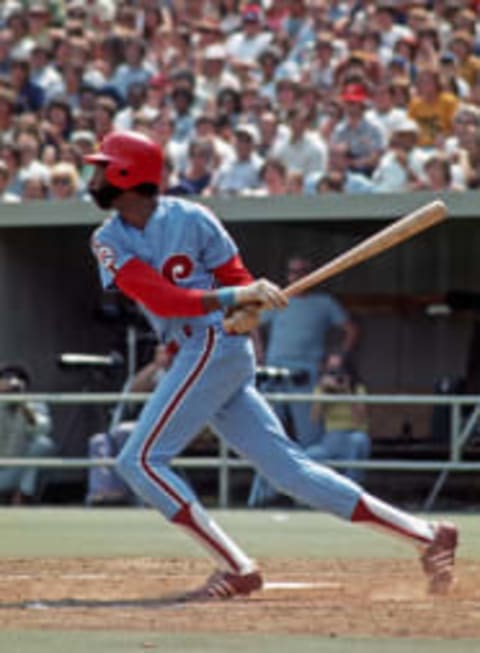
In his first four full seasons with the Phillies Maddox hit at least .280 with 27 doubles and 22 stolen bases, and that was a bad year if he only reached those numbers.
In the 1980 NLCS Maddox hit .300, drove in the game-winning run with a 10th inning double against the Dodgers, and caught the final out to put the Phillies in the World Series for the first time since 1950. During that NLCS he hit
Maddox would play the final 12 years of his career with the Phillies, amassing 1,333 hits, 249 doubles, and 85 home runs as a Phillie. He was inducted onto the Wall of Fame and is considered the second-best center fielder in Phillies history, though perhaps the greatest defender in franchise history.
Things didn’t go as smoothly for Montanez in San Francisco where he only played the remaining 135 games of the 1975 season. He did hit .305 and struck out only five more times than he walked, but the return on investment certainly didn’t match for the Giants.
Montanez would go on to play for the Mets, Pirates, Expos, Braves, Rangers, Padres, and Angels before returning to Philadelphia and playing the final 18 games of his career here.
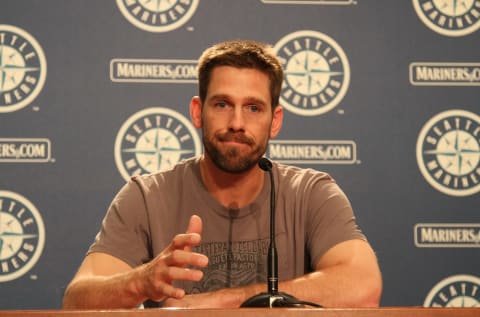
Seattle Mariners: Cliff Lee
On December 16, 2009, the Philadelphia Phillies traded Cliff Lee to the Seattle Mariners for Tyson Gillies, Phillippe Aumont and JC Ramirez.
Coming off a disappointing World Series loss in 2009 the Phillies were determined to get better, even if it ended up in them trading their best pitcher.
The Phillies’ white whale was always Roy Halladay. They tried to get him in 2009, but they settled for Cliff Lee in the aforementioned trade with Cleveland. But this time, they got him.
On December 16 the Phillies traded two of their top-three prospects to get the best pitcher in baseball to push them towards another championship.
But, the Phillies had another move up their sleeves. As general manager Ruben Amaro Jr. would later reveal, there was a mandate to restock the farm system after making moves for Lee, Moyer, Lidge, Blanton, Loshe, and others.
To restock the farm system the Phillies decided to trade arguably their biggest asset and pass on the possibility (for now) to have a rotation of Halladay, Lee, and Hamels.
Shortly after trading for Halladay the Phillies sent Lee packing to the Pacific Northwest for three prospects, all of whom were gigantic busts.

Tyson Gillies was arrested for cocaine possession, but the charges were dropped. After hitting .341 in the Mariners system in 2009 Gillies played just 24 games in 2010 and three games in 2011. The Phillies released him during the 2014 season and he faded off.
JC Ramirez, a right-handed starter turned reliever, made 18 appearances for the Phillies in 2013 with a 7.50 ERA. The team moved on in 2013.
Phillippe Aumont, the Canadian right-hander, might have been the biggest disappointment of the group. He was one of the Mariner’s top pitching prospects coming off some good years in the Seattle farm system.
Aumont floated through the Phillies system with little success as a reliever and starter. He came up to the big leagues in 2012 and walked nine batters in 14 innings. He got 22 more appearances with the Phillies the next year and made six appearances over the next two years before falling out of favor in the organization. He hasn’t pitched in the big leagues since 2015.
The idea of restocking the farm system wasn’t a terrible idea, but the players who they got back in return were.
Honorable Mention
August 19, 2006. The Seattle Mariners traded Jamie Moyer to the Philadelphia Phillies for Andrew Baldwin and Andy Barb.
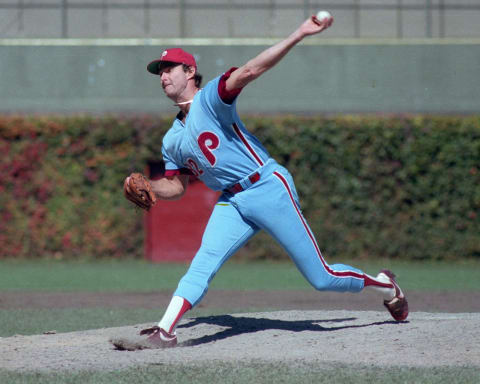
St. Louis Cardinals: Steve Carlton
On February 25, 1972, the Philadelphia Phillies traded Rick Wise to the St. Louis Cardinals for Steve Carlton.
The Phillies entered the 1971 offseason coming off their fifth consecutive losing season. One of the few bright spots was 26-year old pitcher Rise Wise. Not only did he win 17 games, but made his first All-Star appearance and hurled a no-hitter. However, when Wise’s salary demands were more than the Phillies were willing to offer, a trade went down with the Cardinals to acquire 27-year old left-hander Steve Carlton.
Carlton was a three-time All-Star coming off a 20-win season at the time of the trade. Asking for $65,000 the Cardinals refused and Carlton held out. When the trade went down, both he and Wise got single-year deals worth $65,000. The deal appeared to be even at the time, with Carlton edging Wise in career wins by just two.
Make no question about it, the Phillies were a horrendous team in 1972, except when Carlton took the hill. Then it was “win day.” Carlton had a season for the ages on a 59-win team, going 27-10 with a 1.97 ERA. He logged 346 innings in 41 starts, struck out 310, completed 30 games and had eight shutouts. Wise was solid with 16 wins and a 3.22 ERA in 1972 and actually outperformed Carlton in 1973, but then the trade got completely one-sided in favor of the Phillies.
Carlton went on to win 241 games with the Phillies, made seven All-Star appearances, led the league in wins four times, innings five times and strikeouts five teams. Carlton was instrumental to the Phillies success in the 1980 postseason, going 3-0 with a 2.30 ERA. He was even more successful in the 1983 NLCS against the Dodgers, posting a 2-0 record with a 0.66 ERA in 13 1/3 innings.
Wise went on to have six more seasons with at last 10 wins following the trade. He posted a career-high 19 wins in 1975 and made his second and final All-Star appearance in 1973. Wise won 188 games with 1647 strikeouts. While quite respectable, it pales in comparison to Carlton’s 329 wins and 4136 strikeouts.
Rubbing salt into the wounds of the Cardinals, Carlton dominated his former team, going 38-14 for at .731 winning percentage. He was inducted into the Baseball Hall of Fame in 1994 on the first ballot with nearly 96 percent of the vote.
– Kerry Kauffman contributed to this report
Honorable Mention July 29, 2002. The Philadelphia Phillies traded Doug Nickle, Scott Rolen and cash to the St. Louis Cardinals for Placido Polanco, Bud Smith and Mike Timlin. December 11, 1929. The St. Louis Cardinals traded Pete Alexander and Harry McCurdy to the Philadelphia Phillies for Bob McGraw and Homer Peel.
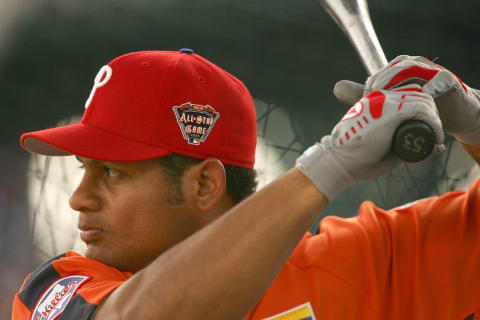
Tampa Bay Devil Rays: Bobby Abreu
On November 18, 1997, the Tampa Bay Devil Rays traded Bobby Abreu to the Philadelphia Phillies for Kevin Stocker.
One of the most underrated players for the Phillies in the early 2000s was Bobby Abreu.
Many forget that Abreu wasn’t a homegrown player for the Phillies and that he bounced around the league early in his life.
Abreu started his career in Houston and had a cup of coffee with the Astros in parts of two seasons. When the Rays came into the league they took Abreu in the expansion draft and immediately swapped him to the Phillies for Kevin Stocker.
Stocker was the Phillies second round pick in the 1991 MLB June Amateur Draft from the University of Washington. He finished sixth in the Rookie of the Year in 1993 and played sporadically for five years hitting .262.
Abreu certainly did much more in his nine years with the Phillies, receiving MVP consideration and consistently hitting .300 or better. In his eight seasons with the Phillies Abreu hit no worse than .286 and hit .300 six times, topping it with a .335 batting average in 1999.
Abreu also put up seven straight seasons of 35 doubles, 20 home runs, and 20 stolen bases. He’s the all-time leader in number of seasons with those stats with nine.
Only Barry and Bobby Bonds (10) had more 20 home run/20 stolen base seasons than Abreu.
Abreu, unfortunately, didn’t play his entire career with the Phillies and was traded to the Yankees. He’s an all-time outfielder in the organization and was inducted onto the Phillies Wall of Fame in 2019. This is one of the best and most underrated trades in franchise history.

Texas Rangers: Cole Hamels
On July 31, 2015, the Philadelphia Phillies traded Jake Diekman, Cole Hamels and cash to the Texas Rangers for Jorge Alfaro, Alec Asher, Jerad Eickhoff, Matt Harrison, Jake Thompson and Nick Williams.
Outside of Cole Hamels‘ miraculous no-hitter on his final start in red pinstripes, the 2015 Phillies season was filled with disappointment. The team’s 99 losses were their most since losing as many in 1969; it was simply time to continue their “rebuild.”
Trading away their 2008 World Series MVP in Hamels did just that, symbolizing a new era in Phillies baseball.
Leading up to the trade, which brought several players including catcher Jorge Alfaro and outfielder Nick Williams to the Phillies’ organization, Hamels had been among the best southpaw starting pitchers in franchise history. Across parts of 10 seasons, half of which the team qualified for the postseason, Hamels had gone 114-90 with a 3.30 ERA, 1,844-492 strikeout-to-walk ratio and 1.145 WHIP over 295 appearances.
His best season came in 2011, during the franchise’s all-time-best 102-win season; Hamels went 14-9 with a. 2.79 ERA and 0.986 WHIP, helping him to a fifth-place Cy Young Award finish.
Hamels will be most remembered, of course, for leading the Phillies’ rotation in the 2008 postseason. He won four of his five starts, including tossing eight shutout innings while allowing just two hits and one walk opposite the Milwaukee Brewers in the NLDS. Hamels went 2-0 with a 1.93 ERA opposite the Los Angeles Dodgers in the NLCS, before shutting down the Tampa Bay Rays in the Fall Classic, going 1-0 with a 2.77 ERA across two starts and 13 innings, including a rain-impacted Game 5.
The left-hander and his wife Heidi may now be a part of the Atlanta Braves family, but they will always be rooted to Philadelphia at heart. Since leaving the Phillies, he has started 88 games for the Texas Rangers, and 39 for the Chicago Cubs. He had signed a one-year pact with the Braves this past offseason, prior to the delay due to COVID-19.
Hamels not only has four All-Star nods, a 2008 World Series trophy and 2015 no-hitter to his credit. In 2014, he and three Phillies relievers combined to toss the first combined no-hitter in Phillies franchise history. Coincidentally, the game was against Hamels’ future team in the Braves.
– Matt Rappa contributed to this report
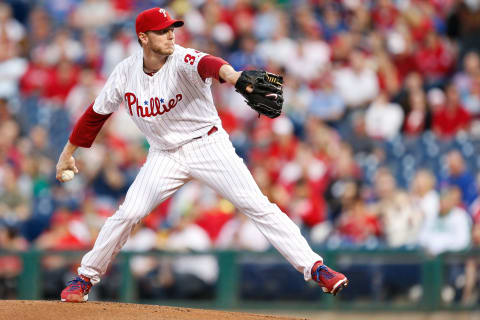
Toronto Blue Jays: Roy Halladay
On December 16, 2009, the Toronto Blue Jays traded Roy Halladay and cash to the Philadelphia Phillies for Travis d’Arnaud, Kyle Drabek and Michael Taylor.
When you talk about the greatest trades in Phillies history, the Roy Halladay deal is up there.
The Phillies gave up some of their best prospects in this deal, including one many thought was an ace in the making in Kyle Drabek. Unfortunately for him, the career didn’t go as planned and he’s been out of the league since 2016.
Michael Taylor, a talented outfielder, was traded in this deal instead of Domonic Brown. Neither panned out. Taylor was traded to Oakland as part of the deal and hit just .167 in 37 big league games.
Travis d’Arnaud is the only prospect traded who turned into a big league player, though the young catcher jumped around the league last year after six seasons with the Mets.
Everyone knows what Halladay did, he was better than advertised. In his first season Halladay threw a perfect game, no-hitter, and won the Cy Young. He really could have won back-to-back Cy Youngs after leading the league with eight complete games in 2011. He led the league in complete games seven times in a nine year stretch.
It’s unfortunate that Halladay’s body broke down at the end of his career and the Phillies couldn’t get more than two really good years out of him. The biggest tragedy is that he was taken from his family and this world too soon. One of the greatest players in Phillies history, Halladay will be remembered forever.
Honorable Mention
August 30, 2008. The Toronto Blue Jays traded Matt Stairs to the Philadelphia Phillies for Fabio Castro.
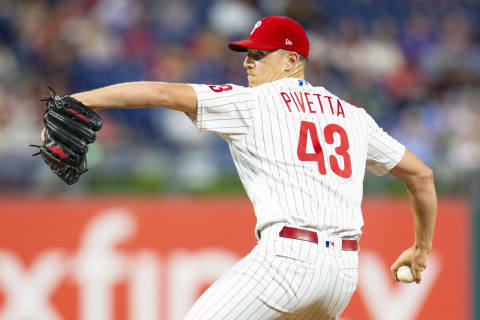
Washington Nationals: Jonathan Papelbon for Nick Pivetta
On July 28, 2015, the Philadelphia Phillies traded Jonathan Papelbon and cash to the Washington Nationals for Nick Pivetta.
When the Phillies signed Jonathan Papelbon just weeks after their heartbreaking 2011 NLDS loss to the St. Louis Cardinals, they were adding among the best closers to ever play the game.
Through seven seasons in a Boston Red Sox uniform, Papelbon posted a 2.33 ERA and 219 saves, while recording 509 strikeouts and just 115 walks across 429 1/3 innings. Papelbon earned four All-Star nods in a Red Sox uniform, and, in the 2007 World Series, tossed 4 1/3 shutout innings coupled with a 0.462 WHIP opposite the Colorado Rockies.
The Phillies had hoped that Papelbon could contribute just as well as Brad Lidge in 2008. While not perfect, he surely outplayed him in terms of regular season play. Through 234 appearances, Papelbon notched a 2.31 ERA and 123 saves, making him the franchise’s all-time saves leader, besting the previous record-holder Jose Mesa (112).
In July 2015, the Phillies opted to deal Papelbon, who they were paying $13 million per year, to the division-rival Washington Nationals in exchange for right-handed pitching prospect and 2013 fourth-round draftee Nick Pivetta.
More from Phillies History
- Philadelphia Phillies achieve franchise feat for first time since 2011
- Phillies History on August 23: Eric Bruntlett records historic triple play
- Remembering Vin Scully: Dodgers voice’s first game was against Phillies
- Phillies in hot water for inviting Pete Rose to 1980 World Series celebration
- 4 Phillies players who skipped the minors and went straight to MLB
Pivetta has since been promoted to the major-league level, being used as a starting pitcher and reliever. He was a candidate to be among the team’s starting pitchers for the 2020 season, prior to spring training and the eventual regular season being delayed.
The controversial Papelbon would finish the 2015 season with the Nationals and would play just one more season overall with them, before his major-league career came to a close. There, he infamous got into a dugout altercation with eventual Phillie Bryce Harper for not running on the base paths. Coincidentally, the game was being played opposite the Phillies.
Papelbon’s 368 saves ranks ninth on the all-time saves list, behind Mariano Rivera (652), Trevor Hoffman (601), Lee Smith (478), Francisco Rodriguez (437), John Franco (424), Billy Wagner (422), Dennis Eckersley (390), and Joe Nathan (377).
– Matt Rappa contributed to this report